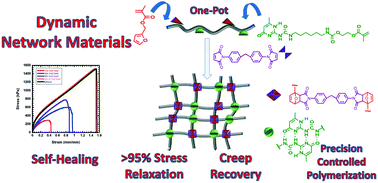Controlling polymer architecture to design dynamic network materials with multiple dynamic linkers†
Abstract
A one pot synthesis is applied to control the chain structure and architecture of multiply dynamic polymers, enabling fine tuning of materials properties by choice of polymer chain length or crosslink density. Macromolecules containing both non-covalent linkers based on quadruple hydrogen-bonded 2-(((6-(3-(6-methyl-4-oxo-1,4-dihydropyrimidin-2-yl)ureido)hexyl)carbamoyl)oxy)ethyl methacrylate (UPyMA), and thermoresponsive dynamic covalent furan–maleimide based Diels–Alder linkers are explored. The primary polymer's architecture was controlled by reversible addition-fragmentation chain transfer (RAFT) polymerization, with the dynamic non-covalent (UPyMA) and dynamic covalent furfuryl methacrylate (FMA) units incorporated into the same backbone. The materials are crosslinked, taking advantage of the “click” chemistry properties of the furan–maleimide reaction. The polymer materials showed stimulus-responsive thermomechanical properties with a decrosslinking temperature increasing with the polymer's primary chain length and crosslink density. The polymers had good thermally promoted self-healing properties due to the dynamic covalent Diels–Alder bonds. Besides, the materials had excellent stress relaxation characteristics induced by the exchange of the hydrogen bonds in UPyMA units.



 Please wait while we load your content...
Please wait while we load your content...
